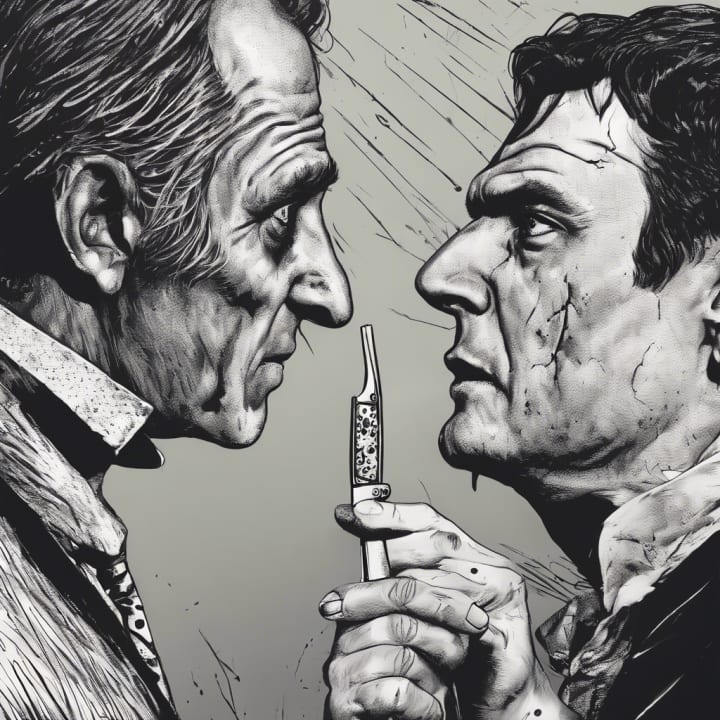Content warning
This story may contain sensitive material or discuss topics that some readers may find distressing. Reader discretion is advised. The views and opinions expressed in this story are those of the author and do not necessarily reflect the official policy or position of Vocal.
Unmasking the Shadows: Distinguishing Psychopaths from Sociopaths in Antisocial Personality Disorder
“Decoding the Dark Side: Differentiating Psychopathy and Sociopathy”

The distinctions between "psychopath" and "sociopath" are frequently hazy when we envision a sinister manipulator behind a litany of horrific deeds. These words conjure up ideas of crafty villains and erratic outlaws, made popular by the media and criminal operas. However, the dramatization conceals a deep and intricate reality. What distinguishes a psychopath from a sociopath in reality? What behavioral symptoms and social effects do these various antisocial personality disorder (ASPD) aspects have? Examining the thoughts of people who have these hidden characteristics and live among us paints an intriguing and frequently scary picture of human psychology.

1. Behind the Mask: The Deceitful Charm of the Psychopath
Psychopaths frequently lurk in our midst, going unnoticed. Their manner is deceptively normal, and they exude an enticing charm. But what is hidden behind this sane mask? This part explores the terrifying traits of psychopathy, exposing the systems that allow psychopaths to easily manipulate and deceive.
Psychopathy is considered a more severe type of ASPD, characterized by a fundamental lack of empathy, manipulativeness, and surface-level charm. Psychopaths can blend in with society so well that they can appear charming or even normal. They frequently utilize their "mask of sanity" to easily manipulate people for their own amusement or benefit.
The characteristics of psychopaths include grandiosity, dishonesty, and superficial feelings. They see people as nothing more than tools to be utilized in their own ways. Contrary to the stereotype of blatantly violent criminals, psychopaths frequently conduct relatively respectable lives, moving up the social or professional ladder while keeping their actual selves hidden. They are especially hazardous because of their capacity for deception since they may function covertly in a variety of social roles, including those of authority.
Neuroscientific studies have demonstrated that psychopaths have altered brain chemistry, especially in regions linked to impulse control and emotion management. Psychopaths typically have an underactive amygdala, which is a fundamental component in emotion processing and helps explain why they are unable to feel fear or empathy the way others do. This neurological foundation contributes to the explanation of why psychopaths are capable of cruel actions without feeling regret or guilt.

2. Unmasking the Sociopath with The Reactive Predator
Sociopaths are erratic and impulsive, in sharp contrast to psychopaths' cold-bloodedness. This chapter delves into the chaotic realm of sociopathy, scrutinizing the irrational actions and emotional outbursts that render sociopaths unpredictable and hazardous. How do their chaotic lives come to pass, and what sets off their reactive aggression?
Sociopaths frequently display more erratic conduct and emotional outbursts. They usually reside on the outskirts of society and struggle to maintain long-term relationships. They behave antisocially and lack empathy, too, although they tend to act more impulsively and carelessly than psychopaths.
A history of turbulent relationships and irregular employment is common among sociopaths. Their unstable upbringing, which may have included abuse or neglect as a youngster, is the cause of their incapacity to develop strong emotional bonds. In contrast to the more intrinsic, potentially hereditary, roots of psychopathy, there is an environmental influence. Sociopaths tend to act more impulsively than deliberately, which can result in violent or criminal outbursts that come out of nowhere.
Sociopaths, in contrast to cold, aloof psychopaths, are capable of developing ties to particular people or groups, albeit these bonds are typically turbulent and rife with conflict. Since they don't have the same level of planning and forethought as psychopaths, their impulsive nature makes them more likely to be apprehended for their crimes.
3. The Sources of Evil: The History of Sociopathy and Psychopathy
Does psychopathy develop over time? Do sociopaths come out of the dark after a difficult past? This section explores the causes of various disorders, looking at environmental factors, genetic predispositions, and the effects of childhood trauma. Deciphering the origins of these characteristics is essential to understanding their complexity.
There has been much discussion and investigation on the causes of psychopathy and sociopathy. Psychopathy is frequently thought to be more intrinsic and to have a large genetic component. Research has demonstrated that psychopathic characteristics can be seen as early as childhood and continue throughout maturity. These people might have a genetic connection if their families have a history of exhibiting such habits.
However, sociopathy is typically thought to be the result of external circumstances. The development of violent, abusive, or neglected childhood experiences is a major factor in the emergence of sociopathic tendencies. Sociopaths frequently originate from chaotic homes with little structure or steady emotional support. Their turbulent surroundings add to their unpredictable and impetuous disposition.
According to recent studies, psychopathy and sociopathy are likely to arise as a result of a hereditary and environmental cocktail. For instance, growing up in a dysfunctional environment may increase the risk of psychopathy in a child who has a genetic susceptibility to the illness. On the other hand, early intervention and support may reduce antisocial tendencies in a sociopathic individual.

4. Evil's Faces: Actual Case Studies
Real-life case studies, ranging from the affable Ted Bundy to the violent Richard Kuklinski, provide insight into the thoughts of sociopaths and psychopaths. This chapter examines well-known individuals whose deeds have irrevocably altered society, highlighting the startling parallels and sharp distinctions between these two categories of criminals.
Ted Bundy, who is frequently described as the embodiment of a psychopath, was skilled at charming and tricking his victims by projecting an image of an intelligent, polite person. His carefully thought-out crimes were a reflection of his cold, cunning personality. Bundy's capacity to control and mislead others around him, including members of law enforcement and his own legal team, emphasizes the characteristics of psychopathy that are necessary for his type: a lack of empathy, a surface-level charm, and a methodical approach to his objectives.
Richard Kuklinski, as "The Iceman," on the other hand, had characteristics more in line with sociopathy. His impulsive behavior and violent outbursts resulted in multiple horrible killings. Kuklinski's interactions, in contrast to Bundy's, demonstrated the unpredictable and short-term planning traits of sociopaths. Rather than being the product of deliberate plans, his crimes were frequently the consequence of sudden rage or perceived slights.
These case studies demonstrate the behavioral distinctions between sociopaths and psychopaths as well as the difficulties law enforcement and mental health providers encounter in recognizing and treating these people. Developing more effective profiling and intervention tactics can be facilitated by having a thorough understanding of the unique characteristics and behaviors linked to each category of offender.
5. The Reaction of Society: Legal Framework, Mental Health Care, and Rehab
How does society deal with people who have sociopathic or psychopathic tendencies? This section looks at how the criminal justice system, mental health providers, and law enforcement identify, treat, and rehabilitate people with ASPD. What steps work, and what obstacles still need to be overcome?
Understanding the distinctive behavioral patterns can help law enforcement profile and catch offenders. In contrast to more impulsive and reactive sociopaths, psychopaths frequently require distinct investigative techniques due to their premeditated and manipulative conduct. It is necessary to adjust interrogation tactics and profiling methods to take these variations into consideration.
Experts in mental health are essential in the diagnosis and treatment of people with ASPD. Although there are few alternatives for treatment, therapy and early intervention can help lessen some of the more harmful behaviors associated with the illness. Though their efficacy varies greatly across individuals, cognitive-behavioral therapy (CBT) and other therapeutic treatments can teach coping mechanisms and impulse control.
Both psychopaths and sociopaths, in spite of their differences, present serious problems for society. Their actions hurt both individuals and communities by upsetting the social order. Educating the public on the subtleties of ASPD is crucial to building a more compassionate and knowledgeable society that can handle these intricate problems with compassion and nuance.

Final Thoughts: The Mysterious Aftereffects of Antisocial Personality Disorder
As we come to the end of our investigation into the complex and frequently unsettling realm of psychopaths and sociopaths, it is evident how important it is to comprehend these aspects of antisocial personality disorder. Beyond merely being intellectual, the differences between psychopathy and sociopathy influence how these people interact with society and how society views them.
Both sociopaths and psychopaths offer different difficulties because of their unpredictable, impulsive behavior and cold, planned manner. We can better position ourselves to handle the threats they provide if we are aware of their characteristics, origins, and actions. Better judicial rulings, more effective mental health interventions, or enhanced law enforcement tactics are just a few ways that our combined knowledge might result in more humane and practical solutions.
By dissecting these multifaceted individuals, we can not only learn more about the darker sides of the human psyche but also promote a society that is more knowledgeable and kind. Let's work to strike a balance between justice and understanding as we uncover more shadows and make sure that our solutions are as complex and multidimensional as the people they are meant to assist.
About the Creator
Enjoyed the story? Support the Creator.
Subscribe for free to receive all their stories in your feed. You could also pledge your support or give them a one-off tip, letting them know you appreciate their work.






Comments (1)
This was such a fascinating read! Thank you so much for sharing!